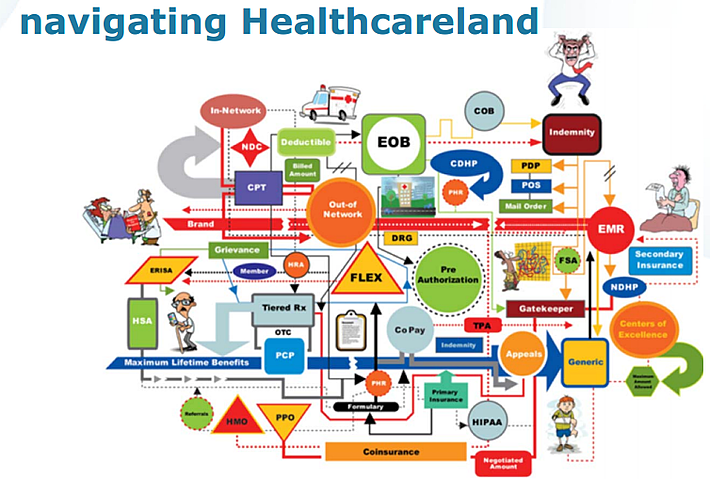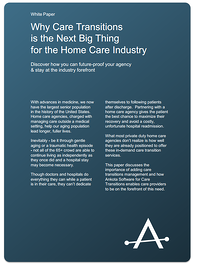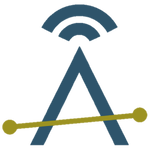The biggest Health Care Technology organization and trade show is called HIMSS (Health Care Information and Management Systems Society). It offers presentations covering many topics across the spectrum of Health IT.
One presentation I enjoyed was from the Chief Physician for Walt Disney World, Michael Hankins (MD, MPH). In the Ankota blog we generally talk about home care, care transitions and related topics, whereas this topic covered managing care for Disney employees.
In classic Disney fashion, a slide was presented that made healthcare look like a theme park. Here's the picture, "Navigating Healthcareland".
 What Do Some of These Definitions and Acronyms Mean?
What Do Some of These Definitions and Acronyms Mean?
I though it might be useful to share what a lot of these terms and acronyms stand for. And away we go...
- Billed Amount: Amount charged for care
- CDHP: Consumer Driven Health Plan
- COB: Coordination of Benefits - figuring out who pays when, for example, both husband and wife have insurance
- Copay: An amount that a member pays (e.g., $30 out-of-pocket) when they see a doctor
- CPT: Codes that are used for specific health care treatments (Current Procedural Terminology)
- Deductable: Out of pocket fee paid by the insured person before insurance kicks in
- DRG: Diagnosis-Related Group - A code used describing treatment for billing
- In Network: using a physician that has a contract with your health plan in your area (as opposed to a doctor not contracted with your insurance and at a higher rate.
- EMR: Electronic Medical Record
- EOB: Explanation of Benefits (a description of what's covered/paid for a claim)
- ERISA: Employee Retirement Income Security Act (protects plan members)
- FSA: Flexible Spending Account
- Grievance: A complaint requiring review and resolution
- HIPAA: Health Information Portability and Privacy Act - makes sure that personal health information is only shared with health providers who need to know it
- HSA: Health Savings Account (savings for people with high deductible plans)
- HMO: Health Maintenance Organization
- NDC: National Drug Code System - codes used for drug billing
- Out of Network: a physician or hospital who is not contracted to provide you care (you can generally get care from anyone, but will likely pay more)
- PCP: Primary Care Physician
- PDP: Prescription Drug Plan
- PHR: Personal Health Record. We highly recommend personal health records be maintained by patients as part of care transition services.
- POS: Point of Service
- PPO: Preferred Provider Organization (type of health plan)
- Pre-Authorization: Some treatments require authorization (e.g., from Primary Care Physician) before seeing a specialist
Why Does this matter to Home Care Agencies?
As I mentioned in the intro, this post is off-topic for our usual home care audience, but I can see two reasons why this is relevant, as follows:
- Everyone needs health insurance and hopefully this post can help demystify some of it for you, and
- Home Care is poised to play a bigger role in health care, helping to provide ongoing care services and care transitions services to help avoid hospitalizations.
If you're interested in learning more about incorporating a Care Transitions program with your Home Care agency , please download our newest free white paper "Why Care Transitions is the Next Big Thing for the Home Care Industry."

Ankota provides software to improve the delivery of care outside the hospital, focusing on efficiency and care coordination. Ankota's primary focus is on Care Transitions for Readmission avoidance and on management of Private Duty non-medical home care. To learn more, please visit www.ankota.com or contact Ankota.




Your Comments :